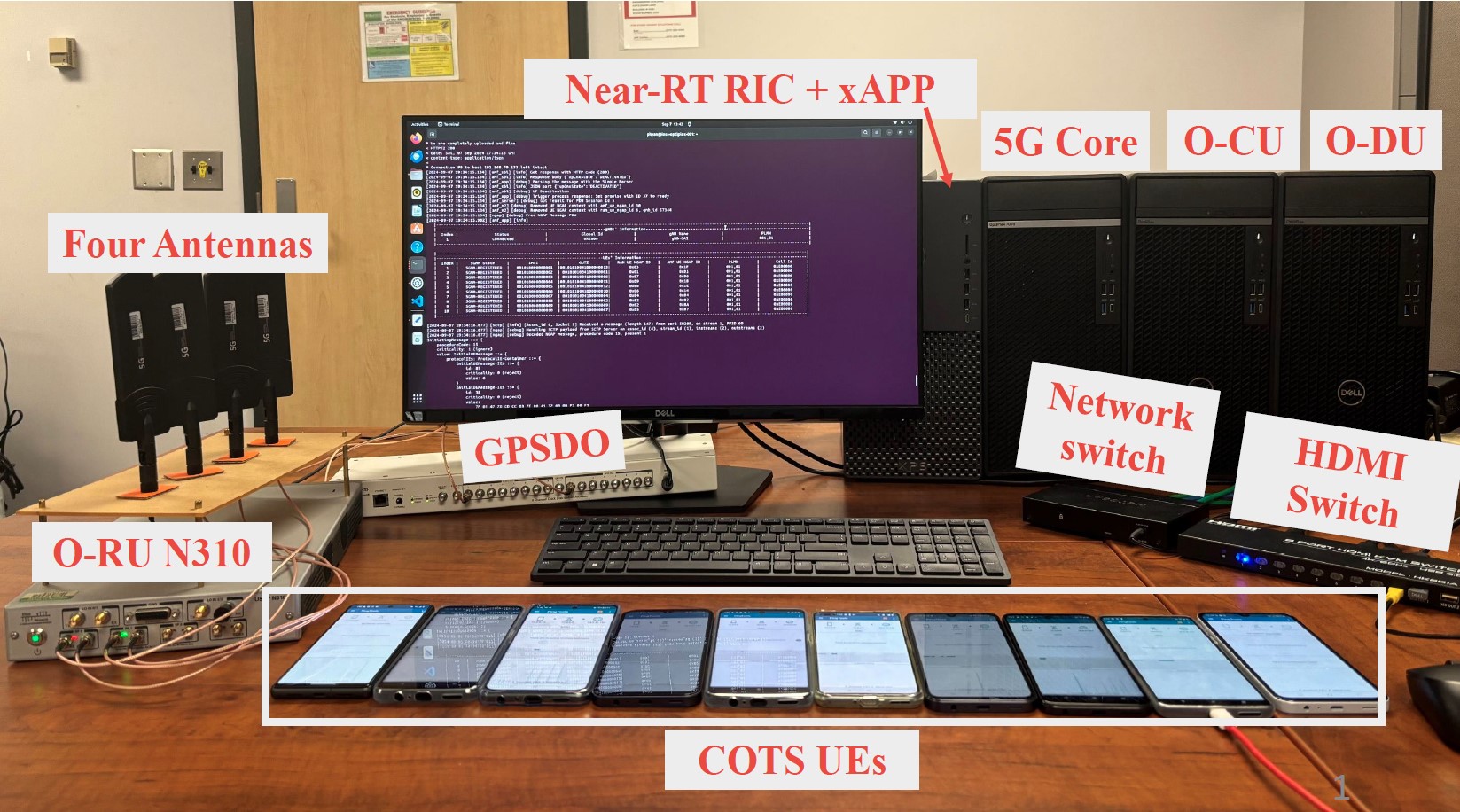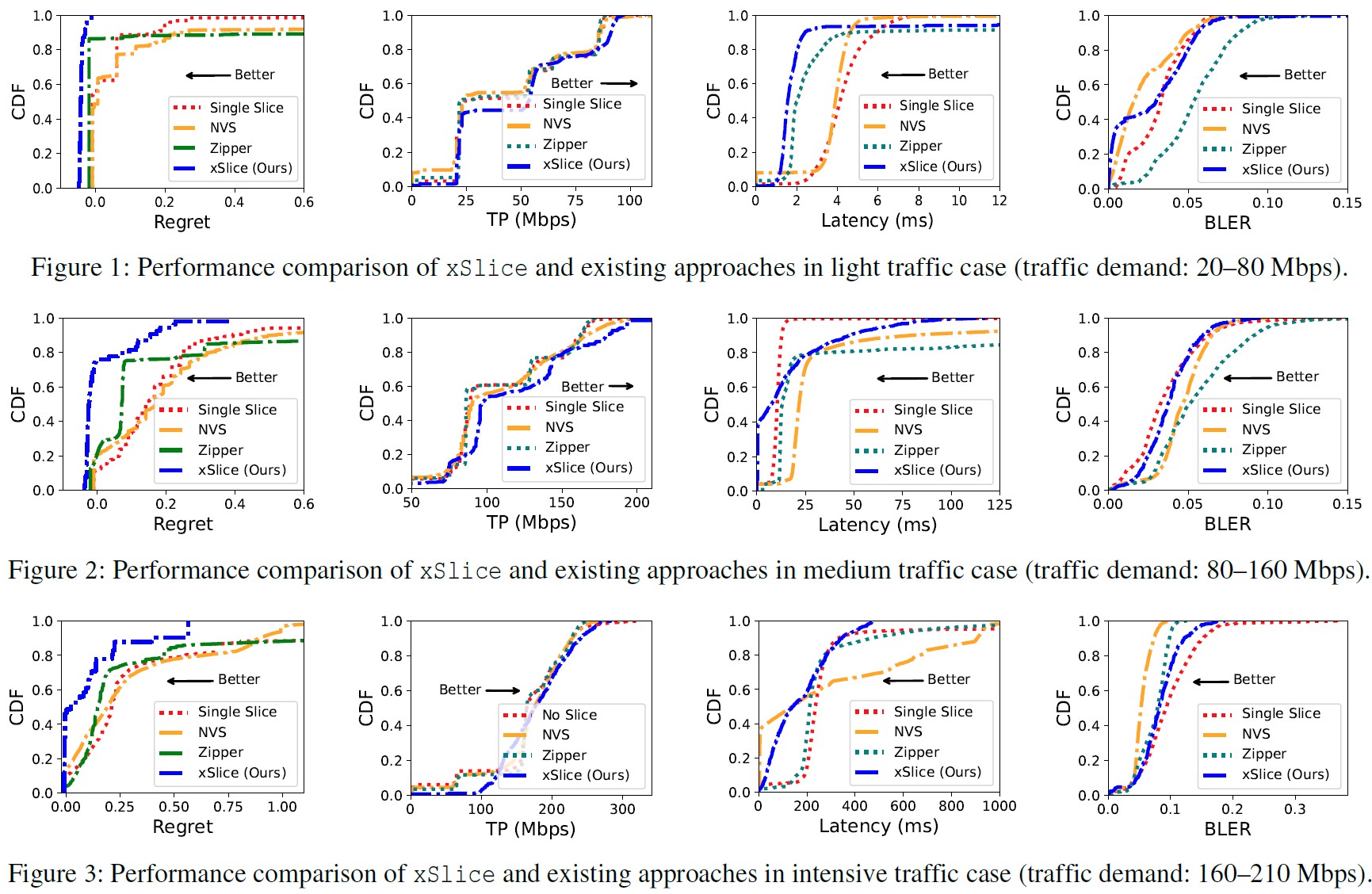Collaborative Research: NeTS: Medium: An Integrated Multi-Time Scale Approach to High-Performance, Intelligent, and Secure O-RAN based NextG
Project Information
Award numbers: NSF 2312448
Project period: 10/1/2023 – 9/30/2026
Principal investigator: Dr. Huacheng Zeng
Graduate student:
Peihao Yan (Ph.D. student)
Shichen Zhang (Ph.D. student)
Project Overview
Recent movement to open up radio access network (RAN) interfaces, led by the O-RAN Alliance, has introduced a new paradigm for future wireless networks. With its key features of openness and intelligence, O-RAN enables a “mix-and-match” approach to RAN development and deployment, allowing telecom carriers to select the best hardware and software from different vendors. Such openness also catalyzes the integration of machine learning (ML) based intelligence into the RAN and promises further performance improvement. This project aims to address several major challenges in O-RAN, with the objective of enhancing its performance, intelligence, and trustworthiness. Through innovation in wireless algorithm and protocol design, ML, and network security, this project expedites the evolution of O-RAN ecosystem. Moreover, the project promotes the participation of women and students with diverse backgrounds in wireless communications and computer science research while enhancing pedagogical activities through new course materials.
This project aims to enhance the performance, intelligence, and trustworthiness of O-RAN by tackling several fundamental challenges across its control loops of three different time scales. The project consists of three interconnected research thrusts. The first thrust focuses on real-time multi-user multi-input and multi-output (MU-MIMO) beamforming in O-RAN's distributed unit (O-DU). It develops a data-driven approach for beamforming that accounts for channel uncertainty. The second thrust focuses on the design of ML algorithms for MU-MIMO control within the near-RT RAN Intelligent Controller (RIC). It establishes an optimization-based framework to generate high-quality labeled datasets for training ML models. The third thrust aims to advance knowledge of the vulnerabilities of ML models in the non-RT RIC of O-RAN and develop safeguard solutions against data manipulation attacks.
The team at Michigan State University will focus on the second research thrust: designing data-driven approaches to enhance the performance of O-RANs. This includes, for example, the development of xAPPs in the Near-RT RIC.
Publications
Research Activities and Outcomes
Year 1 - xAPP design and implementation for near-real-time resource slicing in 5G O-RAN
Overview. Open-Radio Access Network (O-RAN) has become an important paradigm for 5G and beyond radio access networks. This paper presents an xApp called xSlice for the Near-Real-Time (Near-RT) RAN Intelligent Controller (RIC) of 5G O-RANs. xSlice is an online learning algorithm that adaptively adjusts MAC-layer resource allocation in response to dynamic network states, including time-varying wireless channel conditions, user mobility, traffic fluctuations, and changes in user demand. To address those network dynamics, we first formulate the Quality-of-Service (QoS) optimization problem as a regret minimization problem by quantifying the QoS demands of all traffic sessions through weighting their throughput, latency, and reliability. We then develop a deep reinforcement learning (DRL) framework that utilizes an actor-critic model to combine the advantages of both value-based and policy-based updating methods. A graph convolutional network (GCN) is incorporated as a component of the DRL framework for graph embedding of RAN data, enabling xSlice to handle a dynamic number of traffic sessions. We have implemented xSlice on an O-RAN testbed with 10 smartphones and conducted extensive experiments to evaluate its performance in realistic scenarios. Experimental results show that xSlice can reduce performance regret by 67% compared to state-of-the-art solutions. The below figure shows the high-level architecture of our proposed xSlice system in an O-RAN.

Testbed Hardware. The below figure shows our O-RAN testbed, which includes 5G Core, O-CU, O-DU, O-RU and 10 COTS smart- phones. We implement the O-RAN system using 4 servers for O-DU, O-CU, Near-RT RIC, and 5G Core. Specific parameter settings are detailed in Table 3. The hardware configuration of this testbed is designed to support Internet access for COTS smartphones. Local network connection is provided by a Net- gear GS308v3 Ethernet switch, which interconnects the 5G core, O-CU, O-DU, and O-RU components. The O-RU is set up on the USRP N310 device, supporting 4x4 MIMO config- urations. USRP N310 uses external clock GPSDO CDA-2990 to improve its clock accuracy. The radio units are tuned to a center frequency of 3319.68 MHz within the TDD n78 band, with a subcarrier spacing of 30 kHz. The testbed also includes 10 smartphones from OnePlus, Google Pixel, Motorola, and Samsung Galaxy, enabling a diverse range of testing scenarios and performance evaluation. The n78 band was used for this project under an FCC Experimental License with Call Sign

5G Core Support. We have extended 5G core OAICN for this project. The AMF manages user access, authenti- cation, and mobility, while the UPF handles user data traf- fic routing and quality of service. We have added various Slice Service Types (SST), which identify the slice type (e.g., eMBB, URLLC), and Slice Differentiators (SD) to the UPF database. When the NSSAI of a slice matches the correspond- ing SST and SD code in oai-cn5gdatabaseoai_db.sql, the session is assigned to that slice. OAI Modifications. We use OpenAirInterface (OAI) 5G RAN for our experiments. However, OAI does not support sliceing. Therefore, we rewrote the downlink schduler functions in oaiopenair2LAYER2 NR_MAC_gNB and slicing control E2 interface in oaiopenair2 E2APRAN_FUNCTION. We define two attributes SD and SST, for different slices, which serve as unique identifiers for the slices. When a UE connects to the 5G core network, the core database assigns each UE with an SST and SD, as well as 5G QoS Indicator (5QI) and priority level. The DU then assigns a Radio Network Temporary Identifier (RNTI) to each new UE to distinguish it. Additionally, in the Single Slice model, all sessions utilize a single BWP, where the BWP size corre- sponds to the total number of PRBs. For xSlice, we need to define a BWP for each slice, including its starting position and bandwidth size. The size can be obtained through xSlice, while the starting position is determined by traversing through all of the PRBs. xSlice Implementation. We use Mosaic5g Flexric as our near-RT RIC. Flexric contains E2 Node agent, near-RT RIC and xApp. It provide a flatbuffers encodingdecoding scheme as alternative to ASN.1. We use SWIG as an interface generator to enable CC and Python for the xApps. We build our own xApp with E2AP v2.03 and KPM v2.03. We implement xSlice as an xApp within the Near-RT RIC. The Actor-Critic algorithm of the DRL agent is integrated into the PPO framework, supporting online training. The DRL environment is developed in Python for compatibility. xSlice includes both the DRL model and the E2 interfaces for data collection and processing. We have divided the task into two xApps: Monitor xApp and AI-model xApp. The Monitor xApp is responsible for interacting with the RAN to retrieve information (KPM and MAC data) and for sending updated slicing policies to the RAN. The AI-model xApp primarily focuses on model training and online learning. By employing this multiprocess paradigm, xSlice can promptly apply updated policies to the RAN while ensuring that the states acquired accurately reflect the implementation of the new policy actions.
Performance Evaluation. The below figure presents the experimental results in terms of their average values. Numerically, xSlice demonstrates superior performance in terms of regret, throughput, and latency compared to existing policies. Notably, when compared to the state-of-the-art solution Zipper, xSlice reduces performance regret by 67%.

Broader Impacts
PI Zeng hosts undergraduate students to study integrated communication and sensing (ICS) solutions
PI Zeng’s INSS laboratory is hosting two undergraduate students from the Department of Computer Science and Engineering for an innovative research project focused on Integrated Communication and Sensing (ICS). This outreach activity aims to bridge the gap between theoretical knowledge and practical applications, fostering a collaborative environment where students can engage in cutting-edge research. The primary objective of this ICS project is to enhance the capabilities of a single WiFi device by integrating advanced sensing functionalities. The students embarked on a comprehensive study to explore various solutions that enable concurrent transmission and reception of radio signals. This dual functionality is crucial for developing sophisticated applications that can leverage existing wireless infrastructure while adding significant value through new sensing capabilities. The students conducted extensive literature reviews and feasibility analyses. They evaluated current methodologies and technologies that allow for simultaneous signal processing, focusing on the challenges and opportunities within the realm of WiFi devices. Building on their findings, the students then transitioned to the development of deep learning models tailored for novel applications. Among the applications they explored are human body skeleton estimation and mask segmentation. These applications not only demonstrate the practical implications of their research but also address real-world problems, such as improving human-computer interaction and enhancing security measures in various settings. As part of this outreach activity, the students participated in regular presentations and discussions with their peers, faculty, and industry professionals. This interaction is designed to promote knowledge sharing and provide feedback that refine their research direction. Additionally, the students obtained the opportunity to showcase their work at departmental seminars, encouraging other students to engage in research and explore the possibilities within the ICS field.
